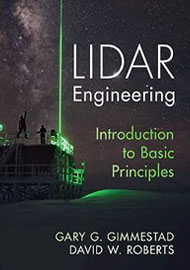
The term lidar was originally introduced to identify instruments for the remote sensing of the atmosphere, while in recent years it has been used (and perhaps abused) to denote rangefinders for the automotive industry.
This book treats the (noble) application of lidar for the measurement of atmospheric parameters, and it originates from a series of lectures offered at the Georgia Institute of Technology, USA, and Galway University, Ireland, thus having the character of a textbook for advanced undergraduates.
The first four chapters of the book provide a general introduction to lidar, discuss the theoretical models of the instrument, and describe the propagation in the atmosphere and scattering regimes. The next four chapters cover the laser transmitter and the receiver, optomechanics issues and optical detection fundamentals.
Processing of the received signal is the topic of the final chapters, with consideration of data systems, lidar data analysis and an overview of applications. Signal inversion through the Klett retrieval algorithm concludes the book, which may be useful for both a course and self study.
Review by Silvano Donati, University of Pavia, Italy
The opinions expressed in the book review section are those of the reviewer and do not necessarily reflect those of OPN or its publisher, Optica (formerly OSA).
